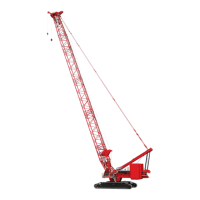HYDRAULIC SYSTEM MLC80A-1/MLC90A-1/MLC100A-1/MLC100-1 SERVICE/MAINTENANCE MANUAL
2-22
Published 10-09-2020, Control # 259-06
NOTE: It is extremely important to perform the bleed
procedure described above in the field anytime the
system is drained completely.
3. Bleed the port (1, Figure 2-2
) on the main hydraulic
pump. This will lubricate the front bearing prior to engine
startup.
NOTE: Ensure all lines cracked during the bleeding
procedure are tightened to specification.
4. Install bleed line shut off valves into the test ports on the
swing pump and utilize them to bleed the air once you
have started the engine at a low idle.
5. While running the engine at a low idle retract and extend
the counterweight pin puller ten times to remove air from
the cylinder.
NOTE: Remove the pin and support the cylinder to prevent
it from striking anything during operation.
6. While running the engine at low engine idle, park and
unpark drum 4 to operate the pawl cylinder a total of 10
times.
7. While running the engine at a low idle, retract and
extend the gantry cylinders to remove air from the
cylinders in the following manner:
a. Extend cylinders 50% out (6”), pause for 2-4
seconds before changing direction, then fully
retract. Pause for 2-4 seconds. Repeat.
b. Extend cylinders 75% out (9”), pause for 2-4
seconds before changing direction, then fully
retract. Pause for 2-4 seconds. Repeat.
c. Extend cylinders 100% out, pause for 2-4 seconds
before changing direction, then fully retract. Repeat
four times.
NOTE: Remove the pin and support the cylinders to
prevent them from striking anything during
operation.
8. While running the engine at a low idle, retract and
extend the crawler extension cylinders to remove air
from the cylinders in the following manner:
a. Extend cylinders 50% out (44”), pause for 2-4
seconds before changing direction, then fully
retract. Pause for 2-4 seconds. Repeat.
b. Extend cylinders 75% out (65”), pause for 2-4
seconds before changing direction, then fully
retract. Pause for 2-4 seconds. Repeat.
c. Extend cylinders 100% out, pause for 2-4 seconds
before changing direction, then fully retract. Repeat
four times.
9. While running the engine at a low idle speed, bleed the
air out of drums 1, 2, 3 (if equipped), and 4 in the
following manner:
a. Ramp the handle command from 0% to 25% (hoist
up) and hold for 15 seconds then ramp to 100% and
hold for 30 seconds.
b. Ramp from 100% hoist up and then down to 0%.
c. Ramp the handle command from 0% to 25% (hoist
down) and hold for 15 seconds, then ramp to 100%
and hold for 30 seconds.
d. Ramp from 100% hoist up and then down to 0%.
e. Repeat steps a—d three times.
NOTE: This step will be done as the machine is being
driven out to test. When you are first moving the
machine out of the building, follow these steps to
ensure that all air is bled from the circuit.
NOTE: Depending on how the machine is parked in the
building, you may start by driving forward or in
reverse.
10. While running the engine at a low idle speed, bleed the
air out of the travel motors in the following manner:
a. Ramp the handle from 0 to 100% command and run
the tracks so that the tumbler rotates minimally
twice.
b. Ramp the command down to 0% and repeat step a
only in the opposite direction.
11. Check for hydraulic leaks and correct any that are found.
12. Stop the engine and fill the hydraulic tank to the proper
level.
CAUTION
Avoid Damage to the Hydraulic System!
If the Hydraulic Fluid Low alarm comes on at any time
during the startup procedure, add oil to the tank.
CAUTION
Equipment Damage!
Check pump pressures during the first two minutes of
operation. If the pressure for any pump is not within the
specified range, stop the engine immediately to prevent
pump damage. Troubleshoot to determine the cause of
the problem.

